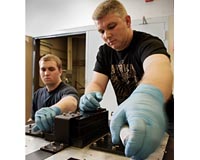 |
Goldstone CA (SPX) Jul 16, 2010 Workers at NASA's Deep Space Network complex in Goldstone, Calif., have been making precise, laser-assisted measurements to ensure a flat surface for pouring new grout as part of a major renovation on the 70-meter-wide (230-foot-wide) "Mars antenna." While officially dubbed Deep Space Station 14, the antenna picked up the Mars name from its first task: tracking NASA's Mariner 4 spacecraft, which had been lost by smaller antennas after its historic flyby of Mars. This work represents the first time network engineers have redesigned and replaced the hydrostatic bearing assembly, which enables the antenna to rotate horizontally. To accomplish this, they lifted the entire rotating structure of the giant antenna for the first time. The hydrostatic bearing assembly puts the weight of the antenna on three pads, which glide on a film of oil around a large steel ring. The ring measures about 24 meters (79 feet) in diameter and must be flat to work efficiently. After 44 years of near-constant use, the Mars antenna needed a kind of joint replacement, since the bearing assembly had become uneven. Engineers and managers at NASA's Jet Propulsion Laboratory in Pasadena, Calif., which manages the Deep Space Network for NASA, drew up plans for new runner segments, new sole plates below the runner segments, and an epoxy grout that is more impervious to oil. The thicker segments deform less when the antenna's pads pass over them, and allow for more tightly sealed joints. Since beginning work in March, engineers and technicians have carefully lifted several million pounds of delicate scientific instruments about five millimeters (0.2 inches) and transferred the weight of the antenna to temporary supporting legs. They have removed the old steel runner and cement-based grout. They have also installed sole plates, which cover the grout and anchor the new runner. Over the past week, JPL engineers checked to make sure the sole plates were level, and workers poured the new epoxy grout underneath to hold them in place. Mixing and pouring the new grout occurred at night to ensure the work was completed within the tight temperature tolerances required to handle this material. Over the next few weeks, the new, thicker steel runner segments will be installed. Work is on track to return the antenna to service on Nov. 1, 2010.
Share This Article With Planet Earth
Related Links Deep Space Network Space Telescope News and Technology at Skynightly.com
 Testing The Webb Telescope Mass Simulator
Testing The Webb Telescope Mass SimulatorGreenbelt MD (SPX) Jul 14, 2010 There are a lot of things that happen "behind the scenes" when a space telescope is being built and all of the components are being tested. A mass simulator is used to replicate the weight and shape of an instrument and is attached to a main component of a space telescope or satellite to test the satellite's durability and sturdiness. The mass simulator is like a "dead weight" that contain ... read more |
|
| The content herein, unless otherwise known to be public domain, are Copyright 1995-2010 - SpaceDaily. AFP and UPI Wire Stories are copyright Agence France-Presse and United Press International. ESA Portal Reports are copyright European Space Agency. All NASA sourced material is public domain. Additional copyrights may apply in whole or part to other bona fide parties. Advertising does not imply endorsement,agreement or approval of any opinions, statements or information provided by SpaceDaily on any Web page published or hosted by SpaceDaily. Privacy Statement |